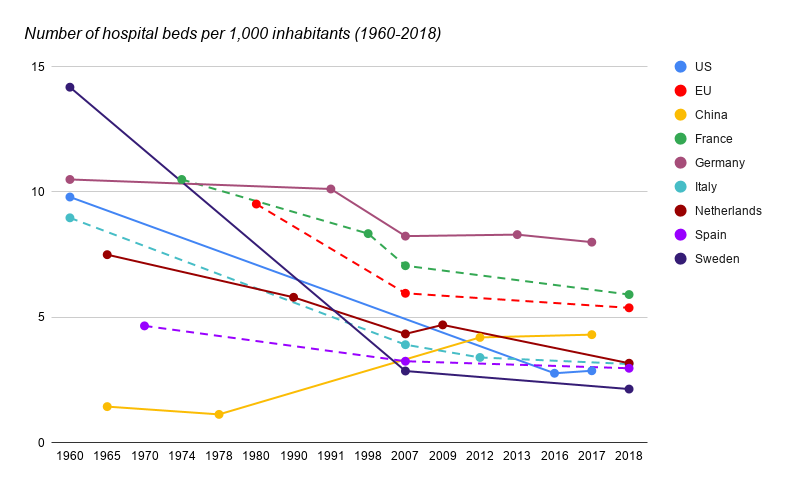Corona restrictions around the world are primarily aimed at not overwhelming hospital capacity. But hospital capacity is not what it used to be. In the 1960s and 1970s, the US and many European countries had around ten hospital beds per thousand inhabitants. Nowadays, the US has less than three, while many European countries have less than five.
Hospital beds are defined as beds that are maintained, staffed, and immediately available for use. Total hospital beds include acute care beds, rehabilitative beds and other beds in hospitals.
North America: 2-3 beds
The USA had 9.18 hospital beds per 1,000 inhabitants in 1960, compared to 2.87 beds in 2017. Canada had 2.52 beds per 1,000 in 2017.
Europe: 2-8 beds
Europe had 9.52 hospital beds per 1,000 inhabitants in 1980, compared to 5.38 beds in 2018. However, there are notable differences between European countries.
In Central Europe, the decrease is relatively limited and the number of hospital beds remains at 6-8 per 1,000 inhabitants:
- Germany: 10.5 (1960) → 10.12 (1991) → 8.24 (2007) → 8.3 (2013) → 8.0 (2017)
- Austria: 9.94 (1985) → 7.75 (2007) → 7.27 (2018)
- Hungary: 9.30 (1994) → 8.16 (2000) → 7.19 (2007) → 7.01 (2018)
- Czechia: 10.11 (1980) → 6.62 (2018)
- Poland: 6.68 (2003) → 6.54 (2018)
In some Western European countries, the decrease is more pronounced, with the number of hospital beds now at 5-6 per 1,000 inhabitants:
- France: 10.5 (1974) → 8.34 (1998) → 7.06 (2007) → 5.91 (2018)
- Belgium: 8.30 (1970) → 7.64 (1989) → 6.27 (2007) → 6.20 (2013) → 5.62 (2018) → 5.58 (2019)
In many other European countries, the number of hospital beds has decreased to around 2-3 per 1,000 inhabitants — similar to the numbers in the US:
- Norway: 3.60 (2017)
- Finland: 8.25 (1993) → 3.61 (2018)
- Netherlands: 7.5 (1965) → 5.8 (1990) → 4.34 (2007) → 4.7 (2009) → 3.17 (2018)
- Italy: 8.97 (1960) → 3.91 (2007) → 3.40 (2012) → 3.14 (2018)
- Ireland: 9.03 (1980) → 2.97 (2018)
- UK: 4.08 (2000) → 2.76 (2013) → 2.54 (2017)
- Denmark: 8.10 (1970) → 4.54 (1997) → 3.69 (2007) → 2.43 (2018)
- Sweden: 14.18 (1960) → 2.86 (2007) → 2.14 (2018)
Finally, some European countries started with much lower numbers:
- Spain: 4.66 (1970) → 3.25 (2007) → 2.97 (2018)
- Greece: 5.79 (1960) → 4.2 (2018)
- Portugal: 3.96 (1985) → 3.45 (2018)
Asia: +10 beds
If we look at China, we see the opposite trend. The number of hospital beds per 1,000 inhabitants grew from 1.44 in 1965 to 4.31 in 2017. China now has more hospital capacity per capita than the US and a great deal of European countries. The countries with the most hospital beds are also in Asia. In 2017, Japan and South Korea had 13.05 and 12.27 hospital beds per 1,000 inhabitants, respectively.
Kris De Decker
Data: Eric Wagner. Graph: Kathy Vanhout.
Sources
- https://www.oecd-ilibrary.org/social-issues-migration-health/hospital-beds/indicator/english_0191328e-en
- https://data.worldbank.org/indicator/SH.MED.BEDS.ZS?end=2015&start=1960&view=map&year=1960
- https://data.oecd.org/healtheqt/hospital-beds.htm
- https://data.oecd.org/healthres/health-spending.htm
- https://ec.europa.eu/eurostat/databrowser/view/hlth_sha11_hf/default/table?lang=en
- https://www.statista.com/statistics/184955/us-national-health-expenditures-per-capita-since-1960/






